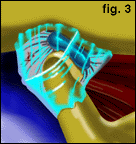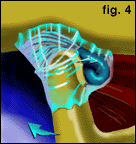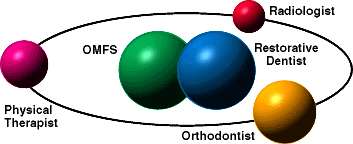- What is TMJ?
- What is TMD?
- How Do We Treat TMD?
- What is Internal Derangement or Anatomical Disease?
- About TMJ Surgery
- Surgical Outcome
What is TMJ?
The Temporomandibular Joint
![[HOME]](/GRFX/MISC/face.gif) The term TMJ is actually an abbreviation for the longer anatomical termtemporomandibular joint. After a few tries, it does not take one long to see why this tongue twister of a term was shortened to TMJ. More specifically, however, the temporomandibular joint is the joint formed by the articulation of the mandible (lower jaw) with the skull. It really means no more than that and you may already have surmised that we all have two of them.
The term TMJ is actually an abbreviation for the longer anatomical termtemporomandibular joint. After a few tries, it does not take one long to see why this tongue twister of a term was shortened to TMJ. More specifically, however, the temporomandibular joint is the joint formed by the articulation of the mandible (lower jaw) with the skull. It really means no more than that and you may already have surmised that we all have two of them.
Unfortunately, over the years, the term TMJ has developed into a long misunderstood and yet commonly used acronym in the vocabulary of both doctors and patients alike. It has come to represent nearly all undiagnosed and painful maladies of the face, head, neck and jaws. As a result of this common misappropriation of terminology, in the last several years there has been a concerted effort on the part of the medical profession to change the acronym to TMD (Temporomandibular Joint Disease) in an effort to more accurately reflect that which is more often being discussed. Nonetheless, the statement, “I have…” or “she has… …TMJ” is likely to stick with us for some time yet to come.
You may also wish to review this case study video for additional information.
What is TMD?
Temporomandibular Disease
Now that we have established our bearings let’s sort out what this problem that we call TMJ or TMD is all about. I am sure that everyone can reflect on someone whom they know that stated, I have TMJ. This is an understandably amusing statement considering the fact that we all have two temporomandibular joints (TMJ’s). However, understanding what was really wrong with that person is where our confusion begins. What condition, out of the several different conditions afflicting this area, did that individual really have.
For the sake of discussion we will attempt to simplify in a very unscientific manner what are actually the most common maladies comprising TMD. As it effects the vast majority of patients, TMD can be broken down into two fundamental conditions. The first is a muscular disorder where related symptoms and jaw dysfunction are primarily a result of muscular spasm in the muscles of jaw function. This condition is more precisely described as myofascial pain dysfunction or MPD.
The second condition is primarily an anatomical disorder whose symptoms and dysfunction result predominantly from anatomical dysfunction of the temporomandibular joint (TMJ). More simply put, this form of TMD results from a failure of the gears or parts of the joint to work smoothly or in harmony with one another. In a rare moment of simplistic brilliance, the medical community has named this problemInternal Derangement. Now, on the surface it would seem pretty simple for someone to figure whether they were suffering from MPD or Internal Derangement.
For more information, you may wish to review our educational videos:
Unfortunately, as you may have guessed, this is not always so. Both conditions present with very similar symptoms which can include but are not necessarily limited to the following: jaw pain, difficulty with jaw opening, earaches, headaches, pain behind the eyes, jaw joint popping and clicking, dizziness, and difficulty chewing food or closing your teeth together.
Already you can begin to see the dilemma with which the misinformed patient and doctor may be presented. We have at least two different conditions that the patient and some doctors have lumped semantically into the single term TMJ or TMD. Whereas two patients claiming to have TMJ may have very similar clinical signs and symptoms, they may actually present with very different physical conditions. To complicate the situation further, as you may have suspected, the two conditions, about which we have spoken, often require different modalities of treatment (Figure 2).
| Myofacial Pain Disfunction MPD | Internal TMJ Derangement True TMD | |
| Muscular Disorder | An Anatomical Disorder | |
| SYMPTOM: Facial Pain Difficulty with jaw opening Headaches Neck Pain |
SYMPTOM: Facial Pain Jaw joint pain Joint clicking or noise Difficulty with jaw opening Earaches Headaches |
|
| TREATMENT: Soft diet Bite Splints Anti-inflammatory medications (Advil, Motrin) Muscle relaxants Physical Therapy Surgery never indicated |
TREATMENT: Soft diet Bite Splints Anti-inflammatory medications (Advil, Motrin) Physical Therapy Surgery may be indicated |
|
How Do We Treat TMD?
As you have learned from our above discussion, the treatment of TMD depends on what form of TMD that you have. Therefore, it is imperative that we, as doctors, must learn specifically if you have TMD and, if so, what kind of TMD do you have. Following a thorough medical history and physical examination, the clinician, whether that is your general dentist or your oral and maxillofacial surgeon, is likely to suggest any or all of the following:
- Jaw rest
- Muscle relaxants and/or anti-inflammatory medication
- A bite splint or night guard
- That you have x-rays taken (Panorex, Arthrotomograms or MRI)
- That you seek the assistance of a registered physical therapist.
All of these modalities are aids in establishing a diagnosis and sometimes assist in rendering definitive treatment. A patient responding to the use of bite splints, muscle relaxants and physical therapy is likely to be suffering from the muscular disorder MPD. Moreover, a patient with the anatomical condition (Internal Derangement) will sometimes receive relief from his/her symptoms with these simple and conservative measures. On the other hand, a patient not responding to these treatment measures may be suffering from a more refractory form of Internal Derangement, which may require confirmation through more sophisticated diagnostic measures such as x-rays and/or MRI. In the event that these diagnostic modalities confirm anatomical disease and the patient continues to suffer from disabling pain and dysfunction your doctor may at this time suggest a surgical approach.
What Actually is Internal Derangement or Anatomical Disease?
 All of us are born with a natural cushion built into most of the joints in our body for the purpose of absorbing shock. This cushion called a meniscus or disc(Figure 3), has different characteristics in different joints but, when injured, can be a source of mechanical failure in all joints. The temporomandibular joint (TMJ) is no different in that respect and is even more complex than most other human joints. Through a feat of mother nature we are capable of virtually unhinging the joint at its usual point of rest in order to move our jaws from side to side or to effect a wider opening. This complex movement during function necessitates a harmonious move by the disc to maintain its protective position.
All of us are born with a natural cushion built into most of the joints in our body for the purpose of absorbing shock. This cushion called a meniscus or disc(Figure 3), has different characteristics in different joints but, when injured, can be a source of mechanical failure in all joints. The temporomandibular joint (TMJ) is no different in that respect and is even more complex than most other human joints. Through a feat of mother nature we are capable of virtually unhinging the joint at its usual point of rest in order to move our jaws from side to side or to effect a wider opening. This complex movement during function necessitates a harmonious move by the disc to maintain its protective position.
 Unfortunately it is not infrequent that this disc can become damaged or displaced (Figure 4). As the disc is damaged or slips from its original position, the individual may experience clicking in the joint as well as joint locking, as the disc malfunctions and becomes an obstruction to normal joint movements. This condition often becomes painful due to sensitive tissues becoming inflamed and swollen. Moreover, nerves associated with these tissues are capable of referring pain to areas away from the original site of the injury resulting in symptoms such as earaches and headaches.
Unfortunately it is not infrequent that this disc can become damaged or displaced (Figure 4). As the disc is damaged or slips from its original position, the individual may experience clicking in the joint as well as joint locking, as the disc malfunctions and becomes an obstruction to normal joint movements. This condition often becomes painful due to sensitive tissues becoming inflamed and swollen. Moreover, nerves associated with these tissues are capable of referring pain to areas away from the original site of the injury resulting in symptoms such as earaches and headaches.
About TMJ Surgery
Although the term surgery is frightening to us all, it is sometimes the most efficient and effective treatment modality. Surgery, however, should not ever be taken lightly and should not be considered a panacea. As you have learned from our discussion above, there are certain forms of TMD, specifically MPD, that should never be treated with surgery. On the other hand, surgery can mean tremendous relief in the patient suffering from intractable anatomical disease or internal derangement (when the discs of our joints are functioning improperly). Surgery can take many forms including:
Arthroscopic Surgery – A procedure performed through a small instrument with a tiny camera attached. The operator may merely loosen some stickiness in the joint or in some cases reposition a displaced disc with the assistance of a laser and operative or surgical arthroscopic techniques.
Open Arthroplasty – A procedure performed by making an incision most often in a skin crease in front of the ear. This procedure is normally aimed at repairing or repositioning a displaced disc but sometimes can result in disc removal (menisectomy). If a disc is removed there are many techniques used today to attempt replacement.
Total Joint Replacement – A procedure performed by sometimes making two incisions, one in front of the ear as in open arthroplasty and one just under the angle of the jaw. This procedure is reserved for more severe and chronic conditions that will not respond to other surgical treatment modalities.
The decision as to which of the above procedures the patient requires, is a decision made by the oral and maxillofacial surgeon. Additionally, some of these decisions cannot be concluded until the surgeon has observed the existing joint pathology in the operating room.
Surgery of the TMJ is almost always performed in a formal operating room as an ambulatory procedure. It is rare, today, that patients require an overnight admission unless a more complicated procedure was indicated or medical evaluation dictates that staying overnight is a prudent thing to do. Most patients will easily return to work in three to five days and suffer only moderate discomfort in the early post-operative period. All are generally restricted to a soft diet for six to eight weeks.
Surgical Outcome
The results from well performed temporomandibular joint surgery have been statistically proven to yield a significant restoration of joint function as well as an increase in overall patient comfort. As with all medical treatments, however, the outcome of surgery is dependent upon proper patient selection, proper surgical technique, and appropriate post-surgical follow-up. It is important to emphasize that surgery alone is not a cure for this form of TMD and that physical therapy and close monitoring of the dental occlusion (bite) are imperative in all cases. A team approach is universally necessary.
If you have further questions regarding this condition or wish to consult with us further, do not hesitate to call for a consultation appointment or use this form to contact us.
A Team Approach = Successful Treatment of TMD or TMJ

The information listed above is the opinion of the doctors of Connecticut Maxillofacial Surgeons, L.L.C. and does not necessarily reflect the opinion of the specialty as a whole.





